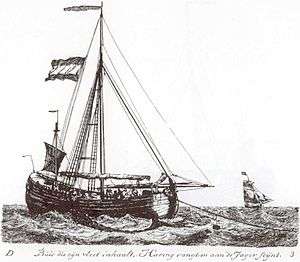Craster kipper

Craster kippers are kippers from the Northumberland village of Craster. They have been acclaimed as the best British kipper.
Background
Like the Newmarket sausage or the Stornoway black pudding, the Craster kipper (sometimes called by aficionados simply "the Craster"[1] ) is a British food named after, and strongly associated with, its place of origin. Although the herrings used for Craster kippers may not be strictly local,[2] the defining characteristic of the Craster kipper is that the smoking process takes place in a smokehouse located in or around the village of Craster.
Clarissa Dickson Wright has named Craster as the birthplace of the kipper.[3] There is however some dispute over this – other places, including the nearby town of Seahouses, also claim this distinction.
Preparation and characteristics
Although a long-standing tradition in Craster, commercial kipper production is currently only continued there by L. Robson & Sons, using their 100-year-old smokehouses.[4]
The preparation process begins with selected raw North Sea herrings, known locally as "silver darlings".[5] These are split, gutted and washed,[6] soaked in brine, and then taken to the smokehouse where they are cured over smouldering oak and white wood shavings for sixteen hours.[7] The famous smokehouse is unmistakable — a stone building often with white plumes pouring out of the wooden vents in the roof.[8]
In appearance a Craster kipper is still recognizably a fish; the head is preserved and the natural colours of the skin are tanned golden by the oak smoke.[1] The flesh has a distinctive reddish-brown colour.[9]
Gastronomic properties
It has been said that comparing the Craster kipper with a common commercial processed kipper is like "comparing a fillet steak with a cheap burger",[1] and that "on the tongue, the [Craster] kipper is as delicate, as sophisticated, as the finest smoked salmon in the world and costs but a fraction of the price."[10]
Craster kippers have been described as "the best", although that claim has also been made of other British kippers such as Loch Fyne kippers.[11]
See also
References
- 1 2 3 Waitrose Food Illustrated. John Brown Contract Publishing. January 2001. Retrieved 6 December 2012.
- ↑ Winpenny, David (1997). Northumbria Papers (Great Britain Guides). McGraw-Hill. p. 23. ISBN 978-0-8442-4882-0.
Craster oak-smoked kippers are famous, but the fresh fish is bought in from elsewhere
- ↑ Dickson Wright, Clarissa (2012). Clarissa's England: A gamely gallop through the English counties. Hodder & Stoughton. ISBN 978-1-444-72909-2.
If you go up the coast further you will come to Craster, the birthplace of the kipper
- ↑ Paul Gogarty (28 April 2008). The Coast Road: A 3,000 Mile Journey Round the Edge of England. Anova Books. pp. 194–. ISBN 978-1-905798-09-4. Retrieved 6 December 2012.
- ↑ Country Life. Country Life, Limited. May 2002. Retrieved 6 December 2012.
- ↑ Bill Griffiths (2006). Stotty 'n' Spice Cake: The Story of North East Cooking. Northumbria University Press. p. 32. ISBN 978-1-904794-13-4. Retrieved 6 December 2012.
- ↑ Gemma Hall (18 September 2012). Bradt Slow Northumberland & Durham: Including Newcastle, Hadrian's Wall and the Coast. Bradt Travel Guides. p. 59. ISBN 978-1-84162-433-4. Retrieved 6 December 2012.
- ↑ Hall, p. 78
- ↑ Andrew McCloy; Stephen Whitehorne (30 January 2009). Coastal Walks Around Britain. New Holland Publishers. p. 88. ISBN 978-1-84773-127-2. Retrieved 6 December 2012.
- ↑ The Connoisseur. 214 (863-868). 1984. Missing or empty
|title=(help) - ↑ Lesley Anne Rose; Michael Macaroon; Vivienne Crow (28 November 2011). Frommer's Scotland. John Wiley & Sons. p. 28. ISBN 978-1-119-97259-4. Retrieved 6 December 2012.
External links
- The commercial web site of L. Robson & Sons Ltd (Craster kipper producers)

